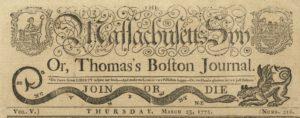The rattlesnake, a uniquely American reptile, was first used as a symbol by Benjamin Franklin, in 1751, in a satirical editorial in the Pennsylvania Gazette. Franklin suggested the colonies thank Britain for sending their convicted criminals to America by sending the British rattlesnakes. The sectioned snake, representing the 13 colonies, was also seen in Paul Revere’s newspaper, Massachusetts Spy, fighting an English dragon, in 1774.
By 1775, Franklin stood behind the rattlesnake as a good symbol for the American Spirit, publishing an essay in the Pennsylvania Journal, and stating:
“I recollected that her eye excelled in brightness, that of any other animal, and that she has no eye-lids—She may therefore be esteemed an emblem of vigilance.—She never begins an attack, nor, when once engaged, ever surrenders: She is therefore an emblem of magnanimity and true courage.—As if anxious to prevent all pretensions of quarreling with her, the weapons with which nature has furnished her, she conceals in the roof of her mouth, so that, to those who are unacquainted with her, she appears to be a most defenseless animal; and even when those weapons are shewn and extended for her defense, they appear weak and contemptible; but their wounds however small, are decisive and fatal:—Conscious of this, she never wounds till she has generously given notice, even to her enemy, and cautioned him against the danger of stepping on her.—Was I wrong, Sir, in thinking this a strong picture
of the temper and conduct of America?”
It is, however, another sectioned snake that offers the most insight into the minds of our forefathers. In this instance, the rattles represent the 12 values, and the sections of the snake represent the 9 principles, not the 13 colonies.
The Twelve Values are:
- Honesty,
- Reverence
- Hope
- Thrift
- Humility
- Charity
- Sincerity
- Moderation
- Hard work
- Courage
- Personal Responsibility, and
- Friendship.
The 9 principles are:
- America is good.
- I believe in God and He is the Center of my Life.
- I must always try to be a more honest person than I was yesterday.
- The family is sacred. My spouse and I are the ultimate authority, not the government.
- If you break the law, you pay the penalty. Justice is blind, and no one is above it.
- I have a right to life, liberty, and the pursuit of happiness, but there is no guarantee of equal results.
- I work hard for what I have, and I will share it with anyone I want to. The government cannot force me to be charitable.
- It is not un-American for me to disagree with authority or to share my personal opinion.
- The government works for me. I do not answer to them; they answer to me.
 This modern-day interpretation was brought to us by the radio and television commentator Glen Beck. Beck reminds us that this flag represents the banner of conservatism, the same calling our forefathers used to be brave and courageous and continue to fight against government control, excessive taxation, the safety and wellbeing of their families, and the right to work hard and thrive. Those were the very rights described in the Declaration of Independence when this great document stated “life, liberty, and the pursuit of happiness.“.
This modern-day interpretation was brought to us by the radio and television commentator Glen Beck. Beck reminds us that this flag represents the banner of conservatism, the same calling our forefathers used to be brave and courageous and continue to fight against government control, excessive taxation, the safety and wellbeing of their families, and the right to work hard and thrive. Those were the very rights described in the Declaration of Independence when this great document stated “life, liberty, and the pursuit of happiness.“.
To fully understand how a fledgling group of colonies could defeat Britain, the most powerful nation on earth, we need only go back to the document’s title: “The Unanimous Declaration of the Thirteen United States of America.” It was unity and the values and principles stated above that created our great country. We must always remember that the enemies of freedom attack unity first. It is the uncivil discourse and divisiveness created by the “isms” (liberalism, socialism, and communism) that all citizens must fear.
Taken from:
http://delawarerepublican.wordpress.com/2009/02/16/unite-or-die/

